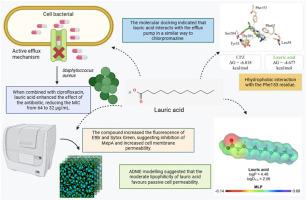月桂酸对金黄色葡萄球菌K2068外排泵抑制的影响:mepA基因调控和膜通透性改变
IF 3.5
3区 医学
Q3 IMMUNOLOGY
引用次数: 0
摘要
在金黄色葡萄球菌中发现的MepA外排蛋白属于MATE (Multidrug and Toxic Compound Extrusion)家族,在细菌耐药过程中起重要作用。我们通过最小抑制浓度(MIC)测定和环丙沙星和溴化乙啶(EtBr)对金黄色葡萄球菌的MIC调节来研究月桂酸作为MepA外排泵抑制剂的潜力;该化合物增强EtBr和Sytox Green荧光的能力,以及抑制mepA基因表达的能力。结果表明月桂酸对金黄色葡萄球菌K2068无抑菌作用。当与环丙沙星联用时,该化合物增强了抗生素的作用,将MIC从64降低到32 μg/mL,并增加了EtBr和Sytox Green的荧光,表明抑制了MepA,增强了细胞膜的通透性。此外,qPCR分析显示月桂酸促进mepA基因表达的降低。分子对接表明,月桂酸与外排泵的相互作用方式与氯丙嗪类似,通过与Phe153残基的疏水相互作用。ADME模型显示月桂酸的中等亲脂性有利于被动细胞通透性。实验结果表明,月桂酸和环丙沙星在模型中的毒性较低。总之,这些发现表明月桂酸可能是一种很有前途的抗生素佐剂和金黄色葡萄球菌MepA外排泵抑制剂。本文章由计算机程序翻译,如有差异,请以英文原文为准。

Effect of lauric acid on efflux pump inhibition in Staphylococcus aureus K2068: Regulation of the mepA gene and membrane permeability alterations
MepA efflux protein found in Staphylococcus aureus belongs to the MATE (Multidrug and Toxic Compound Extrusion) family and plays an important role in bacterial resistance. We investigated the potential of lauric acid as an inhibitor of the MepA efflux pump by means of Minimum Inhibitory Concentration (MIC) assays and modulation of the MICs of ciprofloxacin and ethidium bromide (EtBr) against S. aureus; the compound's ability to increase the fluorescence of EtBr and Sytox Green, as well as its ability to inhibit the expression of the mepA gene. The results showed that lauric acid had no antibacterial effect against S. aureus K2068. When combined with ciprofloxacin, the compound potentiated the effect of the antibiotic, reducing the MIC from 64 to 32 μg/mL and increasing the fluorescence of EtBr and Sytox Green, suggesting inhibition of MepA and greater permeabilization of the cell membrane. Furthermore, qPCR assays revealed that lauric acid promoted a reduction in mepA gene expression. Molecular docking indicated that lauric acid interacts with the efflux pump in a similar way to chlorpromazine through hydrophobic interaction with the Phe153 residue. ADME modeling suggested that lauric acid's moderate lipophilicity favors passive cell permeability. The results of the toxicity assays in D. melanogaster indicate that lauric acid and ciprofloxacin exhibit low toxicity in the evaluated model. Together, these findings suggest that lauric acid could be a promising antibiotic adjuvant and MepA efflux pump inhibitor in S. aureus.
求助全文
通过发布文献求助,成功后即可免费获取论文全文。
去求助
来源期刊

Microbial pathogenesis
医学-免疫学
CiteScore
7.40
自引率
2.60%
发文量
472
审稿时长
56 days
期刊介绍:
Microbial Pathogenesis publishes original contributions and reviews about the molecular and cellular mechanisms of infectious diseases. It covers microbiology, host-pathogen interaction and immunology related to infectious agents, including bacteria, fungi, viruses and protozoa. It also accepts papers in the field of clinical microbiology, with the exception of case reports.
Research Areas Include:
-Pathogenesis
-Virulence factors
-Host susceptibility or resistance
-Immune mechanisms
-Identification, cloning and sequencing of relevant genes
-Genetic studies
-Viruses, prokaryotic organisms and protozoa
-Microbiota
-Systems biology related to infectious diseases
-Targets for vaccine design (pre-clinical studies)
 求助内容:
求助内容: 应助结果提醒方式:
应助结果提醒方式:


